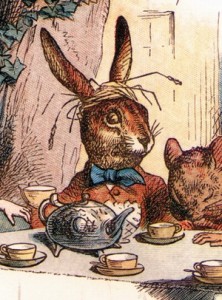The March Hare

The March Hare from Lewis Carroll’s, Alice’s Adventures in Wonderland. Illustration by John Tenniel.
Far from the Perfect Circle of the Sky
The White Rabbit put on his spectacles. “Where shall I begin, please your Majesty?” he asked. “Begin at the beginning,” the King said gravely, ”and go on till you come to the end: then stop.” (L. Carroll)
The March hare has risen amidst the March thaw in search of spring. Soon the bounty of nature will be upon us as new growth and blossoms speak to us of new beginnings. So too the landscape of the Great War, upon the fields, towns, villages and cities will feature the cyclical joys of nature offering solace and colour to the weary eye turned grey to years of war. The hare will hop from burrow to burrow, hedgerow to hedgerow, garden to garden as men continue to feel the rasp of fragments hot burst from their barrels or shredded fragments that pierce the blue and smoke-filled ‘scape. The hare may be mad in his search for amour, une jeune fille but for soldiers there can only be thoughts of love, no new beginnings at this time. There is more war to come in the Spring of 1918.
On 21 March 1918 the Kaiser’s Battle…the German Spring Offensive on the Western Front commenced. With the addition of 500,000 troops newly released from the Russian Front, the German command was confident of victory. Still there would be nearly eight more months of war. And in that time a generation of hares would have its leverets, its youth, adolescence and maturity. The hare would continue to hop amidst the minds of men whose lives, like the sword of Damocles, hung “far from the perfect circle of the sky.”
The March Thaw
Edwin Curran – March 1918
On – turgid, bellowing – tramp the freshet rills
Heaped up with yellow wine, the winter’s brew.
Out-thrown, they choke and tumble from the hills,
And lash their tawny bodies, whipping through.
With flattened bells comes scudding purple rain;
The cold sky breaks and drenches out the snow.
Far from the perfect circle of the sky
The heavy winds lick off the boughs they blow;
And fields are cleansed for plows to slice again,
For April shall laugh downward by and by.
With purifying blasts the wind stalks out
And sweeps the carrion of winter on;
It prods the dank mists, stamps with jest about,
And sows the first blooms on the greening lawn.
Far up the planks of sky the winter’s dross
Goes driven to the north; her rank smells wave
In unseen humors to the icy pole.
The charwomen of the sky, with brushes, lave
And wash the fields for green , and rocks for moss,
And busily polish up the earth’s dull soul.
Did You Know?
Alice Liddell (1852 – 1934) was a young acquaintance of author Lewis Carroll (1832 – 1898) and may have been the inspiration for Carroll’s character Alice in Alice’s Adventures in Wonderland (1865). Alice married Reginald Hargreaves and the couple had three sons, Alan Knyveton Hargreaves, Leopold Reginald Hargreaves and Caryl Liddell Hargreaves.
Captain Alan Hargreaves DSO, age 33, was killed with the 2nd Battalion, Rifle Brigade 9 May 1915 and is buried at Le Trou Aid Post Cemetery, Fleurbaix, France.
Captain Leopold Hargreaves MC, age 33, was killed serving with the Irish Guards, 25 September 1916 and is buried at Guillemont Road Cemetery, Guillemont, France.

Comments